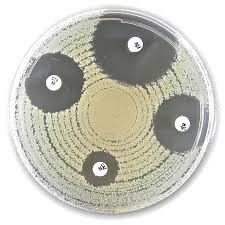Liofilchem® Ceftaroline CPT, Antimicrobial Susceptibility Discs, 30 µg
Catalog No :
CAS Number :
Brand :
In Stock
Specifications:
| Application | Antimicrobial Susceptibility and Resistance Testing (AST) |
| Storage Temperature | 2-8°C |
| Product Type | Antibiotic Disc |
| Product Brand | Liofilchem |
| Product Grade | Microbiology grade |
The Liofilchem® Ceftaroline (CPT) Antimicrobial Susceptibility Discs, 30 µg are designed for in vitro disc diffusion testing to determine the susceptibility of bacteria to ceftaroline, a fifth-generation cephalosporin. Ceftaroline is active against a range of Gram-positive and some Gram-negative organisms and is notable for its effectiveness against methicillin-resistant Staphylococcus aureus (MRSA).
Each disc contains 30 µg of ceftaroline, formulated according to CLSI and EUCAST standards, and is used in standardized antimicrobial susceptibility testing procedures using Mueller-Hinton agar.
These discs are widely used in clinical microbiology laboratories, hospital infection control, research, and antimicrobial surveillance programs, especially when testing for multidrug-resistant pathogens.
Key Features
- High-quality 30 µg potency per disc, meeting international AST standards.
- Reliable detection of ceftaroline susceptibility, especially for MRSA and other multidrug-resistant Gram-positive organisms.
- Certified manufacturing under ISO 9001 and ISO 13485 quality management systems.
- Ready-to-use discs individually sealed in aluminum blister packs with desiccant for optimal stability.
- Compatible with manual and automated disc dispensers and standard AST workflows.
Specifications
| Attribute | Details |
|---|---|
| Antibiotic Agent | Ceftaroline (CPT) |
| Potency | 30 µg |
| Disc Diameter | 6 mm |
| Test Method | Kirby-Bauer disc diffusion |
| Compliant Standards | CLSI M100, EUCAST guidelines |
| Recommended Media | Mueller-Hinton agar (standard or with additives) |
| Storage Conditions | 2–8 °C |
| Shelf Life | 24 months |
| Intended Use | In vitro diagnostic use (IVD) |
Use Cases
1. Detection of MRSA Susceptibility to Ceftaroline
Ceftaroline is one of the few β-lactams effective against MRSA. These discs are routinely used to assess S. aureus, especially methicillin-resistant strains, for ceftaroline susceptibility to guide therapy in serious infections such as:
- Bloodstream infections
- Pneumonia
- Complicated skin and soft tissue infections
2. Testing of Multidrug-Resistant Streptococci and Gram-negative Isolates
While ceftaroline has primary activity against Gram-positive cocci, it is also tested against select Gram-negative organisms such as Haemophilus influenzae and E. coli, especially in:
- Respiratory samples
- Surgical site infections
- Nosocomial pathogen surveillance
3. Antibiogram Development and Resistance Surveillance
- Used by microbiology labs to update local antibiograms.
- Integrated into hospital stewardship programs to monitor resistance trends and inform empirical prescribing policies.
4. Research and Drug Development
Ideal for academic and clinical researchers investigating:
- Resistance evolution in MRSA
- Ceftaroline activity across diverse bacterial species
- Synergy testing with other β-lactams or inhibitors
Testing Procedure
-
Prepare the Inoculum
- Prepare a 0.5 McFarland standard suspension of the test organism using sterile saline or broth.
-
Inoculate the Mueller-Hinton Agar Plate
- Swab the surface of the agar uniformly with the inoculum using a sterile swab.
-
Apply the Ceftaroline Disc (30 µg)
- Place one disc on the agar surface using sterile forceps or a disc dispenser.
- Ensure discs are firmly in contact with the agar and evenly spaced.
-
Incubate the Plate
- Invert and incubate at 35 ± 2 °C for 16–20 hours in ambient air.
- Use 5% CO₂ for Streptococcus pneumoniae or other fastidious organisms if needed.
-
Measure and Interpret the Zone of Inhibition
- Measure the diameter of the zone (in mm) with a ruler or caliper.
-
Compare zone size to CLSI or EUCAST breakpoint tables for interpretation:
- Susceptible (S)
- Intermediate (I)
- Resistant (R)
Interpretation Standards (Reference – Always Check Latest CLSI/EUCAST)
| Organism | Susceptible (S) | Resistant (R) |
|---|---|---|
| Staphylococcus aureus | ≥ 24 mm (CLSI M100) | ≤ 21 mm |
| Streptococcus pneumoniae | Refer to CO₂-based method guidelines | — |
Note: Always consult the current year CLSI or EUCAST documentation for accurate interpretive criteria.
Comparison with Related AST Discs
| Product | Agent | Target Organisms | Use |
|---|---|---|---|
| Liofilchem® Ceftaroline (CPT) 30 µg | Ceftaroline | MRSA, MSSA, Streptococci | Detect β-lactam susceptibility in MRSA |
| Liofilchem® Vancomycin 30 µg | Vancomycin | MRSA, Enterococci | Glycopeptide resistance screening |
| Liofilchem® Linezolid 30 µg | Linezolid | Gram-positive cocci | Oxazolidinone class AST |
| Liofilchem® Cefepime 30 µg | Cefepime | Gram-negative bacilli | Broad-spectrum cephalosporin susceptibility |
Unique Advantages of Liofilchem® Ceftaroline Discs
- Precision Formulation: Delivers consistent diffusion and accurate zone measurements.
- Regulatory Compliance: Meets international AST standards for clinical use.
- Extended Shelf Life: Stable for 24 months when stored correctly.
- Broad Application: Effective for routine diagnostics, surveillance, and academic research.
- Trusted Manufacturer: Produced by Liofilchem®, a globally recognized provider of IVD microbiology products.
For In Vitro Diagnostic Use Only. Not for therapeutic use.




 0
0
